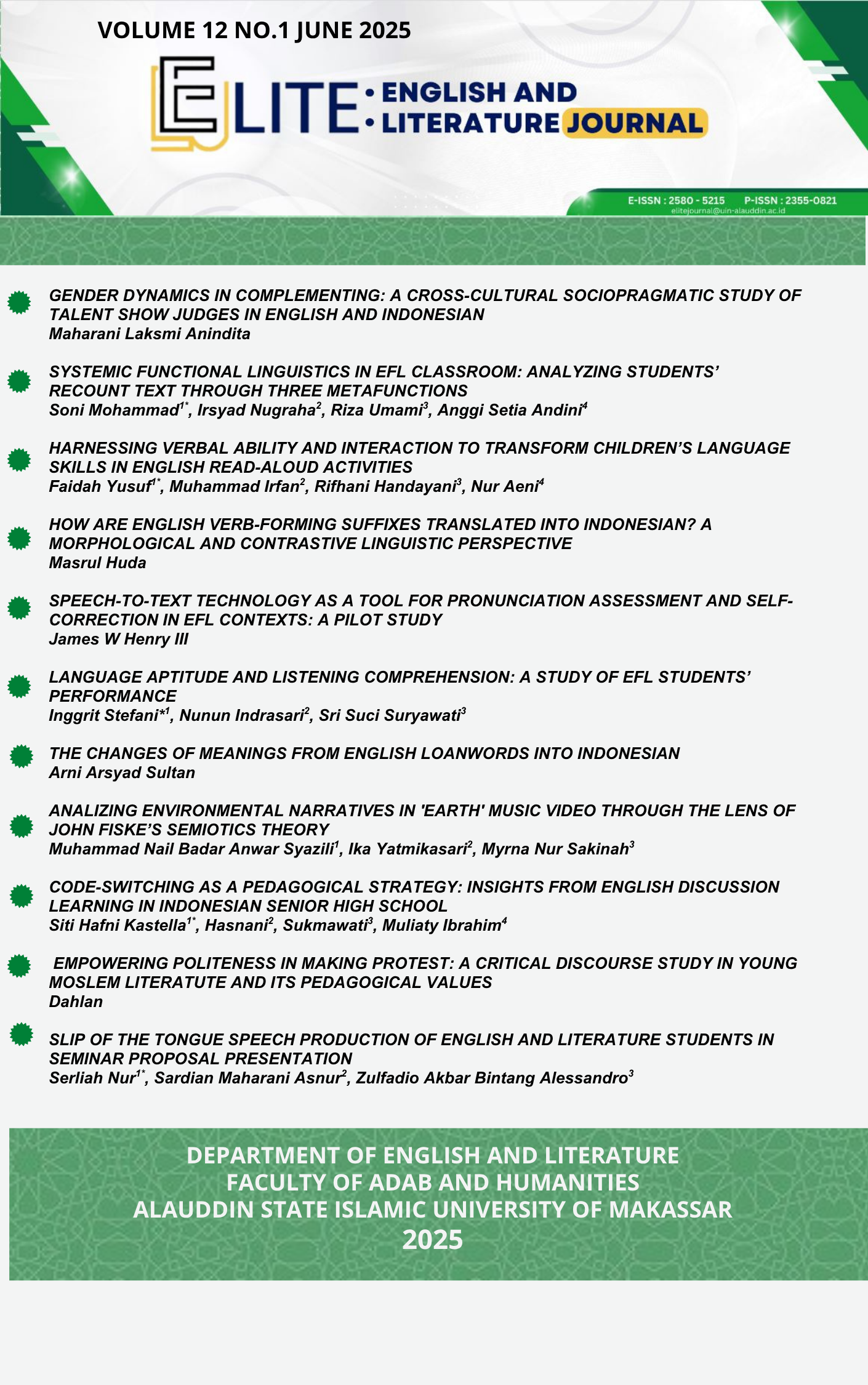HARNESSING VERBAL ABILITY AND INTERACTION TO TRANSFORM CHILDREN'S LANGUAGE SKILLS IN ENGLISH READ-ALOUD ACTIVITIES
Keywords:
Elementary Education; Interaction; Language Skill; Read-Aloud; Verbal Ability., Elementary education, Interaction, Language Skill, Read Aloud , Verbal AbilityAbstract
This study explores the impact of verbal ability and interaction on children’s language skills during English read-aloud activities. Read-aloud sessions are widely recognized as a pivotal method to enhance children’s cognitive and linguistic development. The research employed a structural equation modeling approach to analyze data from 108 children aged 6 to 9 years participating in interactive English storytelling sessions. Key variables included verbal ability, interaction, and language skill development. Findings reveal that verbal ability significantly influences language skills, with a path coefficient of 0.400 (p = 0.001), underscoring its critical role in vocabulary acquisition and sentence construction. Interaction, though showing a moderate effect (0.185, p = 0.068), highlights the importance of collaborative learning and engagement in strengthening comprehension and contextual language use. Additionally, the response to read-aloud stories demonstrate a meaningful contribution (0.331, p = 0.009), emphasizing the role of narrative exposure in fostering linguistic competence. These findings provide actionable insights for educators and parents, suggesting that incorporating interactive elements and verbal practice into English read-aloud sessions can significantly boost children’s language skills. This research contributes to the growing body of literature on effective language development strategies and emphasizes the importance of creating engaging, communicative learning environments.
Downloads
References
Alatalo, T., Norling, M., Magnusson, M., Tjäru, S., Hjetland, H. N., & Hofslundsengen, H. (2024). Read-aloud and writing practices in Nordic preschools. Scandinavian Journal of Educational Research, 68(3), 588–603. https://doi.org/10.1080/00313831.2023.2175243.
Baker, D. L., Santoro, L., Biancarosa, G., Baker, S. K., Fien, H., & Otterstedt, J. (2020). Effects of a Read Aloud Intervention on First Grade Student Vocabulary, Listening Comprehension, and Language Proficiency.
Clegg, J., & Milligan, L. O. (2021). Multilingual learning and language-supportive teaching in Rwandan learning materials. Multilingual Learning and Language Supportive Pedagogies in Sub-Saharan Africa, 201–227. https://doi.org/10.4324/9781003028383-14.
Dündar-Coecke, S., Tolmie, A., & Schlottmann, A. (2020). Children’s reasoning about continuous causal processes: The role of verbal and non-verbal ability. British Journal of Educational Psychology, 90(2). https://doi.org/10.1111/bjep.12287.
Fornell, C., & Larcker, D. F. (1981). Fornell, C. and Larcker, D.F. (1981), “Evaluating structural equation models with unobservable variables and.pdf. Journal of Marketing Research, XVIII(February).
Grenfell, M., & Harris, V. (2002). Modern Languages and Learning Strategies. Modern Languages and Learning Strategies. https://doi.org/10.4324/9780203013823//Modern-Languages-Learning-Strategies-Michael-Grenfell-Vee-Harris.
Hadley, E. B., Newman, K. M., & Kim, E. S. (2023). Identifying Levers for Improvement: Examining Proximal Processes and Contextual Influences on Preschool Language Development. Early Education and Development, 34(1). https://doi.org/10.1080/10409289.2021.1979835.
Hair, J., & Alamer, A. (2022). Partial Least Squares Structural Equation Modeling (PLS-SEM) in second language and education research: Guidelines using an applied example. Research Methods in Applied Linguistics, 1(3). https://doi.org/10.1016/j.rmal.2022.100027.
Håland, A., Hoem, T. F., & McTigue, E. M. (2021). The Quantity and Quality of Teachers’ Self-perceptions of Read-Aloud Practices in Norwegian First Grade Classrooms. Early Childhood Education Journal, 49(1), 1–14. https://doi.org/10.1007/s10643-020-01053-5.
Hutton, J. S., Horowitz-Kraus, T., Mendelsohn, A. L., Dewitt, T., & Holland, S. K. (2015). Home Reading Environment and Brain Activation in Preschool Children Listening to Stories. Pediatrics, 136(3), 466–478. https://www.irc.cchmc.
Jeremic, Z., Jovanovic, J., & Gasevic, D. (2009). Semantically-Enabled Project-Based Collaborative Learning of Software Patterns. 2009 Ninth IEEE International Conference on Advanced Learning Technologies. https://doi.org/10.1109/icalt.2009.106.
Karatsareas, P. (2022). Research Methods in Language Attitudes: Semi-Structured Interviews. American Journal of Play, 12(2), 99–113. https://doi.org/10.1017/9781108867788.010
Karhulahti, V.-M., & Backe, H.-J. (2021). Transparency of peer review: a semi-structured interview study with chief editors from social sciences and humanities. Research Integrity and Peer Review, 6(1). https://doi.org/10.1186/s41073-021-00116-4
Kozdras, D., Haunstetter, D. M., & King, J. R. (2006). Interactive Fiction: ‘New Literacy’ Learning Opportunities for Children. E-Learning and Digital Media, 3(4), 519–533. https://doi.org/10.2304/elea.2006.3.4.519.
Lin, L. C. (2014). Learning word meanings from teachers’ repeated story read-aloud in EFL primary classrooms. English Language Teaching, 7(7). https://doi.org/10.5539/elt.v7n7p68.
Magno, F., Cassia, F., & Ringle, C. M. (2024). A brief review of partial least squares structural equation modeling (PLS-SEM) use in quality management studies. TQM Journal, 36(5). https://doi.org/10.1108/TQM-06-2022-0197.
Mechanic, A. (1964). The responses involved in the rote learning of verbal materials. Journal of Verbal Learning and Verbal Behavior, 3(1), 30–36. https://doi.org/10.1016/s0022-5371(64)80056-6
Pangrazio, L., & Sefton-Green, J. (2019). The social utility of ‘data literacy.’ Learning, Media and Technology, 45(2), 208–220. https://doi.org/10.1080/17439884.2020.1707223
Ridwan, M. R., Hadi, S., Jailani, J., & Retnawati, H. (2023). The instrument development to measure the verbal ability of prospective high school students. International Journal of Evaluation and Research in Education, 12(1). https://doi.org/10.11591/ijere.v12i1.22736
Saarah, H. M. (2017). The Implementation Of Interactive Read Aloud In Teaching English To Efl Young Learners. Journal of English and Education, 5(2).
Shabani, K., Khatib, M., Tabataba’i Uinversity, A., & Ebadi, S. (2010). Vygotsky’s Zone of Proximal Development: Instructional Implications and Teachers’ Professional Development (Vol. 3, Issue 4). www.ccsenet.org/elt
Snow, R., Federico, P., & Montague, W. (2021). Aptitude, Learning, and Instruction: Volume 1: Cognitive Process Analyses of Aptitude.
Tsunemoto, A., Uludag, P., McDonough, K., & Isaacs, T. (2023). The Relationship between Japanese EFL Learners’ Perceived Fluency and Temporal Speech Measures in a Read Aloud Task. JALT Journal, 45(1). https://doi.org/10.37546/JALTJJ45.1-5
Wang, H., Lu, S., & Liu, Y. (2022). Missing data imputation in PLS-SEM. Quality and Quantity, 56(6). https://doi.org/10.1007/s11135-022-01338-4
Downloads
Published
How to Cite
Issue
Section
License
Copyright (c) 2025 Faidah Yusuf

This work is licensed under a Creative Commons Attribution-NonCommercial-ShareAlike 4.0 International License.
Once an article was published in the journal, the author(s) are:
granted to the journal right licensed under Creative Commons License Attribution that allows others to share the work with an acknowledgement of the work's authorship.
permitted to publish their work online in third parties as it can lead wider dissemination of the work.
continue to be the copyright owner and allow the journal to publish the article with the CC BY-NC-SA 4.0 license
receiving a DOI (Digital Object Identifier) of the work.













